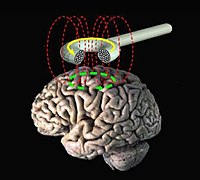
Photo from wikipedia
ABSTRACT Introduction: Since the introduction of burst spinal cord stimulation for neuropathic pain, several companies have developed their own version of burst stimulation, which is confusing the marketplace and clinicians… Click to show full abstract
ABSTRACT Introduction: Since the introduction of burst spinal cord stimulation for neuropathic pain, several companies have developed their own version of burst stimulation, which is confusing the marketplace and clinicians of what burst stimulation truly is, the value and utilization of the therapy. Areas covered: We review those two burst stimulation designs and notice important differences. The original burstDRTM stimulation tries to mimic physiologic burst firing, which involves closely spaced high frequency sodium spikes nested on a calcium mediated plateau. This is realized by generating a train of 5 monophasic spikes of increasing amplitude with passive charge balance after the last spike, in contrast to the other burst designs which involve a version of cycling 4–5 spikes each being individually actively charge balanced spikes. Expert opinion: Based on the neurobiology of burst firing as well as abductive reasoning we like to clarify that burstDRTM is a true physiologic burst stimulation, and that other versions being called burst stimulation are essentially clustered tonic stimulation. This differentiating terminology will prevent confusion for healthcare providers, regulators, and the marketplace of what burst stimulation is.
Journal Title: Expert Review of Medical Devices
Year Published: 2020
Link to full text (if available)
Share on Social Media: Sign Up to like & get
recommendations!